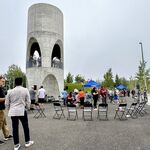JasonParis
Moderator
I ride the 54 Lawrence daily and that route has just gone completely accessible. It dawned on me this morning that I may never ride a fishbowl again! Sort of mixed feelings about that.
Maybe it's also that there isn't the mass sentimentality t/w standard postwar North American vehicular design, however "classic". When it comes to Europe, Beetles and Minis are revered. When it comes to America, it's more about specific-make fashion and bling than year-to-year familiarity. One's less likely to speak of Chevy Impalas at large than of a, say, '64 Chevy Impala. Meanwhile, Model Ts and K-Car econoboxes were/are stigmatized as utilitarian drudges...
London's black cabs still look great.There are very few European transit vehicles running around right now that evoke much sentimentality.
Considering that London's population nearly doubles during the work-day vs. the sleeping hours, I assume those black cabs are making a good business on workers from the suburbs who train in the morning, and use the cabs to get around during the day, and of course, the tourists.That they do, but few who live in London actually take them.
The new buses work better, but they don't turn heads
John Barber
Globe & Mail Feb 16, 2008
I hopped aboard the Bay Street bus the other day and fell headlong into my youth. It was a vintage GMC New Look, identical to the gleaming aluminum dream machine that wheeled into the wide-open imagination of a boy crazy for all things modern in the wonderful 1960s.
Shopping malls, highway interchanges, high-rise apartment buildings, I couldn't get enough of it. Even the buses were spectacular. Polished and riveted like airplanes, with their side windows raked forward and a curtain wall of angled glass up front, the New Looks were designed to make an impression - not just to replace the fusty imagery and stagecoach engineering of the past, but to blow it up.
It worked for me. It worked again half a century later, as I settled into eerily familiar surroundings and marvelled at the fact that nothing's as good as it used to be. That, plus the fact that no other transit authority in the developed world continues to operate, and lovingly maintain, such ancient buses.
Until recently, local bus spotters report, the oldest rubber-tired warrior in the Toronto Transit Commission fleet was No. 2153, a fourth-generation New Look delivered in 1977. The oldest New Look still working today is said to be No. 2017, dating from 1981. Altogether there are more than 200 of these amazing relics still providing comfortable, reliable service in Toronto - and nowhere else.
Generations of more-or-less crummy city buses have emerged from different factories since General Motors quit the business in the 1980s. None of them were built well enough to last much more than a decade. So when the TTC found itself in need of new buses in the mid-nineties, it chose to rebuild its already vintage fleet rather than buy the junk a disorganized industry then had on offer.
It wasn't the first time Canadians had clung obstinately to the iconic bus. When GM tried to phase out the New Look in 1969, several Canadian transit agencies complained. The result was the Classic, an updated New Look made for the Canadian market.
The old GM buses were at the heart of the audacious rebuild program. When the TTC ran out of its own New Looks, it bought wrecks from Montreal and rebuilt them. David Gunn, then TTC chief, boasted that he operated the busiest bus factory in North America.
The old stalwarts stood in long enough to allow the TTC and other transit agencies to develop a worthy successor - essentially by dictating its specifications to the manufacturer. The result is the Orion VII, rolled out in 2003, with a theoretical service life of 18 years. But it's a homely appliance compared to the New Look.
It's not even modern. The lightweight New Look had a frameless monocoque structure, with a stressed skin of riveted aluminum. Despite fancy hybrid engines and a stainless-steel frame, the new buses are strictly traditional.
Imagine if the most sophisticated airplanes flying today were 40 years old, and the newer ones all used technology from the 1930s. The result is an appropriate image of the North American city bus.
Just don't blame the General! As its now-obsolete city buses attest, the car maker once served the cause of public transit with unequalled skill. In their heyday the modern GM buses were a triumphant reply to the false charge that General Motors once conspired to destroy U.S. transit by buying up and decommissioning street railways.
That remains one of the most durable urban myths in existence, but it's just not true. Many, if not most, cities at the time were eager to ditch their streetcar systems, which were unprofitable. Buses were the "young and honest" municipal alternative to the crooked "traction trusts." Their great advantage was that they mixed beautifully with cars.
GM supplied both to a willing market, accepting the clapped-out rail systems as trade-ins on new bus sales. The famous antitrust case that gave rise to the conspiracy theory led to one conviction on an unrelated charge of monopolizing bus manufacture and a $5,000 fine. But it clearly stung the company, which then went out of its way to share new bus technology with competitors - before vacating the market altogether.
GM's crime wasn't a conspiracy to sell buses, but the decision to stop doing so. With that, the city bus became a second-tier product manufactured by a bewildering succession of undercapitalized, state-supported firms. The worst buses ever were half made in Communist Hungary and half made in an Ontario government factory in Mississauga. Riders paid the price.
The new buses work better, but they don't turn heads. When York Region started its new Viva service, it went thousands of miles out of its way - to Belgium - to buy buses sexy enough to attract riders. Down here in Toronto, we at least have the consolation of a glorious past, still rolling.
Fishbowls are great, but the TTC Orion Vs (the ones from early 90s) have always had a place in my heart. The engine wasn't too loud, and the interior and seating plan imo was pretty good. I find the engine sounds in the new buses really loud and annoying.




